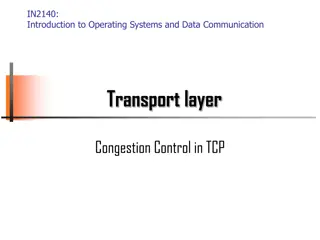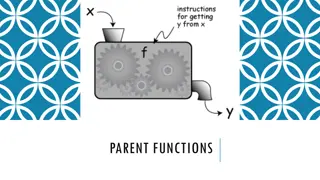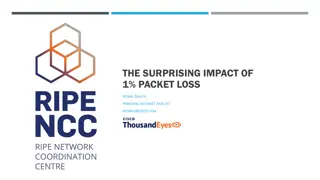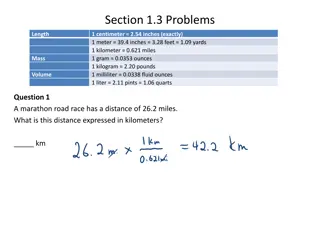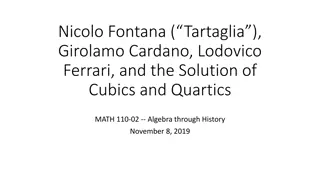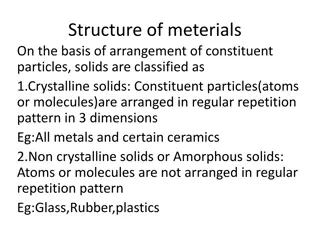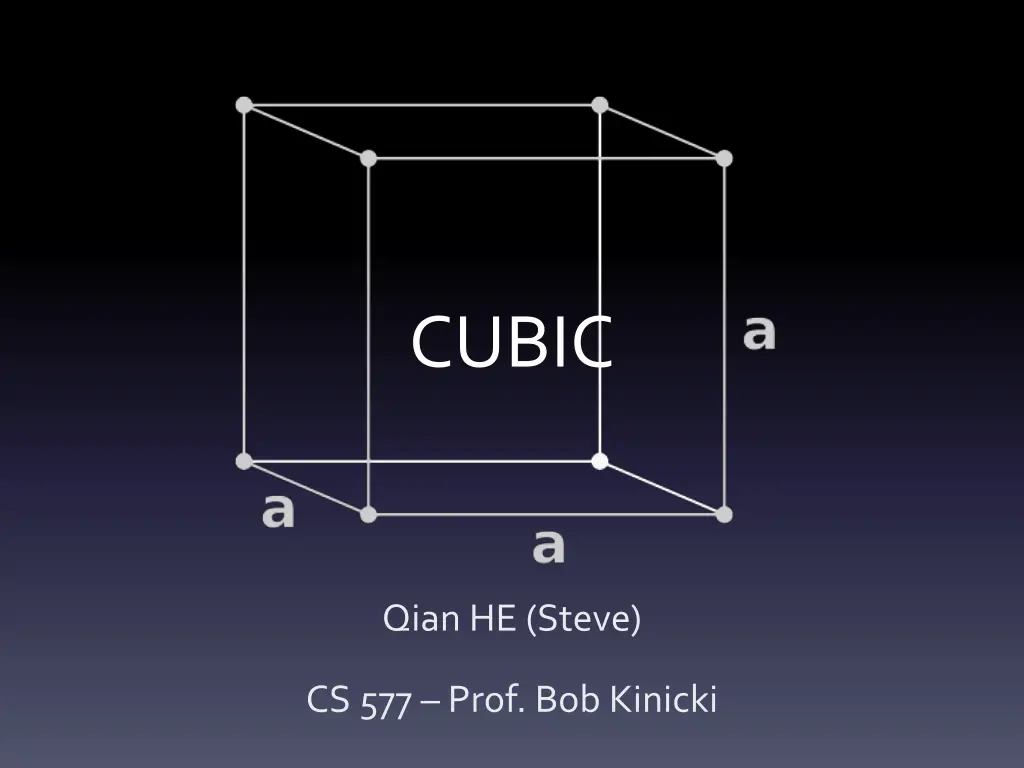
Understanding CUBIC TCP Congestion Control Algorithm
Explore the CUBIC TCP congestion control algorithm, a systematic derivative of BIC, focusing on its less aggressive approach and cubic window function based on time since the last congestion event. Discover the need for CUBIC TCP in high-speed networks compared to Standard TCP and BIC, addressing issues of underutilization and low window size resilience. Learn about the goals and benefits of BIC in achieving scalability, RTT fairness, TCP friendliness, and bandwidth fairness.
Download Presentation

Please find below an Image/Link to download the presentation.
The content on the website is provided AS IS for your information and personal use only. It may not be sold, licensed, or shared on other websites without obtaining consent from the author. If you encounter any issues during the download, it is possible that the publisher has removed the file from their server.
You are allowed to download the files provided on this website for personal or commercial use, subject to the condition that they are used lawfully. All files are the property of their respective owners.
The content on the website is provided AS IS for your information and personal use only. It may not be sold, licensed, or shared on other websites without obtaining consent from the author.
E N D
Presentation Transcript
CUBIC Qian HE (Steve) CS 577 Prof. Bob Kinicki
Agenda Brief Introduction of CUBIC Prehistory of CUBIC Standard TCP BIC CUBIC Conclusion 1
Brief Introduction CUBIC is a less aggressive and more systematic derivative of BIC, in which the window is a cubic function of time since the last congestion event, with the inflection point set to the window prior to the event. 2
Why do we need CUBIC-TCP? Compares to: Standard TCP BIC-TCP 3
Standard TCP Underutilization of the bandwidth in High-Speed Network 1 0.9 Cannot fully utilize the huge capacity of high- speed networks! 155622 Link Utilization 0.8 0.7 2500 0.6 5000 0.5 0.4 10000 0.3 0 2000 4000 Link Capacity (Mbps) 6000 8000 10000 NS-2 Simulation (100 sec) Link Capacity = 155Mbps, 622Mbps, 2.5Gbps, 5Gbps, 10Gbps, Drop-Tail Routers, 0.1BDP Buffer 5 TCP Connections, 100ms RTT, 1000-Byte Packet Size 4 Presentation: "Congestion Control on High-Speed Networks , Injong Rhee, Lisong Xu, Slide 6
Standard TCP Low window size resilience to packet loss in High-Speed Network 1.4 hours 1.4 hours 1.4 hours Packet loss 100,000 Packet loss Packet loss Packet loss TCP cwnd 10Gbps 50,000 5Gbps Slow Increase cwnd = cwnd + 1 Fast Decrease cwnd = cwnd * 0.5 Slow start Congestion avoidance Time (RTT) 5 Presentation: "Congestion Control on High-Speed Networks , Injong Rhee, Lisong Xu, Slide 7
Why BIC? Existing schemes have a severe RTT unfairness problem RTT unfairness for high-speed networks occurs distinctly with drop tail routers for flows with large congestion windows where packet loss can be highly synchronized. 6
BIC Binary Increase Congestion Control (BIC) for Fast Long-Distance Networks , Lisong Xu, Khaled Harfoush, and Injong Rhee, IEEE INFOCOM 2004 7
Goals of BIC Scalability: BIC can scale its bandwidth share to 10 Gbps around 3.5e-8 loss rates (comparable to HSTCP which reaches 10Gbps at 1e-7). RTT fairness: for large windows, BIC s RTT unfairness is proportional to the inverse square of the RTT ratio as in AIMD. TCP friendliness: BIC achieves bounded TCP fairness for all window sizes. Around high loss rates where TCP performs well, its TCP friendliness is comparable to STCP s. Fairness and convergence: compared to HSTCP and STCP, BIC achieves better bandwidth fairness over both short and long time scales, and faster convergence to a fair bandwidth share. 8
BIC Algorithm If cwnd < low_window, Else, BIC normal TCP: ACK received cwnd = cwnd + 1 Enter recovery cwnd = cwnd * 0.5 9
BIC Algorithm Recovery ACK received If cwnd < Wmax If cwnd < Wmax Wmax = cwnd * (1 / 2) cwnd += (Wmax cwnd) / 2 Else Else Wmax = cwnd cwnd += cwnd - Wmax cwnd *= 1 - Smin <= cwnd && cwnd <=Smax 10
BIC with no lost Smin 256 224 192 160 cwnd 128 Linear Search 96 Binary Search with Smax and Smin 64 Smax 32 0 0 1 2 3 4 5 6 7 8 9 10 11 12 13 14 15 16 17 18 19 20 Time (RTT) 11
"Binary Increase Congestion Control (BIC) for Fast Long-Distance Networks", Lisong Xu, Khaled Harfoush, and Injong Rhee 12
Why CUBIC? Window control of BIC is so complex! BIC s growth function can still be too aggressive for TCP, especially under short RTT or low speed networks. BIC still has room for improving TCP- friendliness and RTT-fairness! 13
CUBIC Algorithm Recovery ACK received Update K with: ( ) 3+WmaxK = b Wmax/C cwnd =C t-K 3 C is a scaling factor t is the elapsed time from the last Update Wmax with: Wmax=b Wmax window reduction cwnd cannot be less than cwnd =b Wmax+3 1-b Wmax is the window size just 1+b t RTT before the last window reduction as to keep the growth rate the same as standard TCP in short RTT networks. K is updated at the time of last lost is a constant multiplication event decrease factor 14
CUBIC window curves with competing flows (NS simulation in a network with 500Mbps and 100ms RTT), C = 0.4, = 0.8.15
Window Growth Function CUBIC BIC "CUBIC: A New TCP-Friendly High-Speed TCP Variant", Injong Rhee, and Lisong Xu 16
Stability 4 flows of a high-speed TCP variant over a long-RTT network path (~220ms) 4 flows of long-term TCP-SACK flows over a short-RTT path (~20ms) "CUBIC: A New TCP-Friendly High-Speed TCP Variant", Injong Rhee, and Lisong Xu 17
Coefficient of Variation (CoV) There is no well-defined metric of stability. CoV =s Often the CoV of transmission rates are m used to depict stability. For a less satisfactory measure, we plotted the CoV of throughput. "CUBIC: A New TCP-Friendly High-Speed TCP Variant", Injong Rhee, and Lisong Xu 18
CoV - 20% BDP "CUBIC: A New TCP-Friendly High-Speed TCP Variant", Injong Rhee, and Lisong Xu 19
CoV - 200% BDP "CUBIC: A New TCP-Friendly High-Speed TCP Variant", Injong Rhee, and Lisong Xu 20

